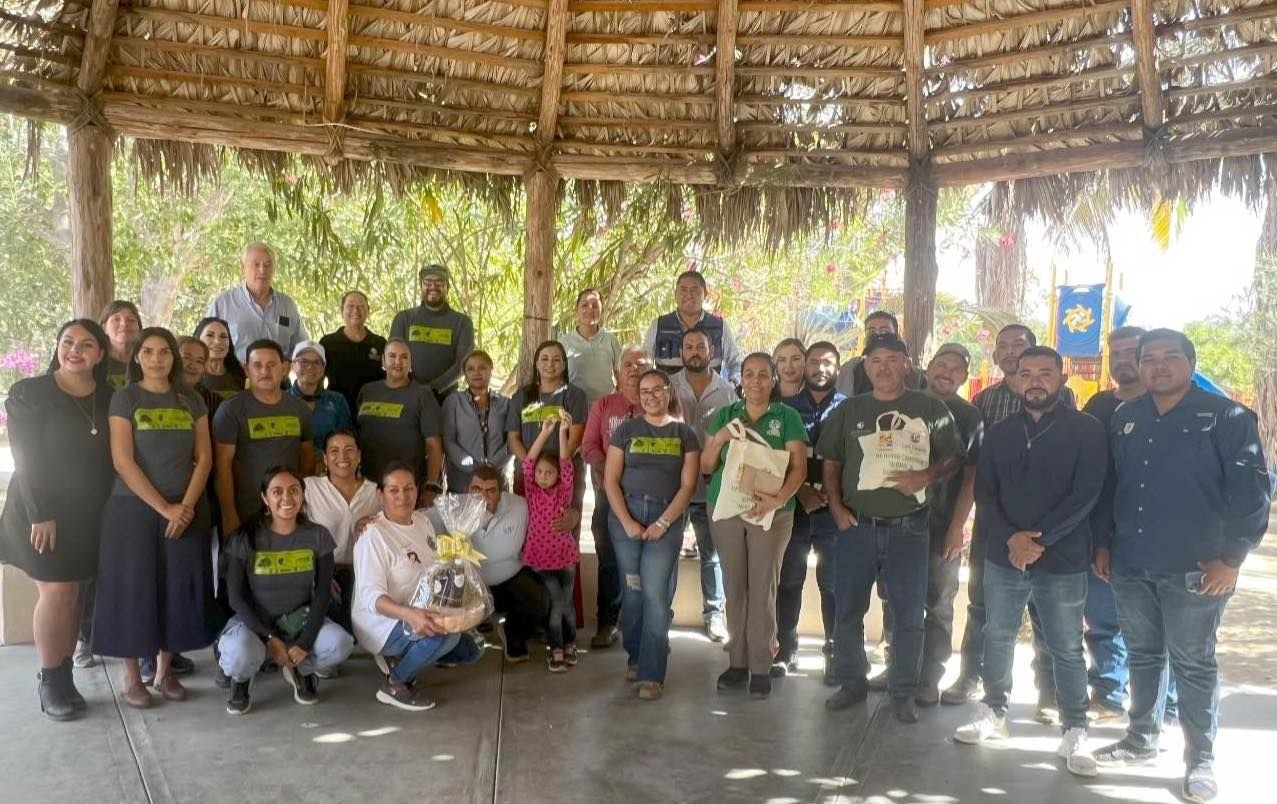LET’S SAVE THE ARROYO OAK: A CALL TO PROTECT OUR NATURAL HERITAGE
By: BCI
If you ever walk through the canyons of Baja California Sur, especially in the Cabo region near the Sierra La Laguna, you might be lucky enough to see a tall, strong tree, full of acorns and broad leaves that provide deep shade in the middle of the arid landscape. This is the Arroyo Oak (Quercus brandegeei), an endemic species—meaning it exists only here—that has witnessed generations come and go, offering food, shelter, and cool shade in a land where shade is a treasure. But there's a problem: this tree is disappearing, and to prevent it, we must take action.
Science and Action
Since 2016, researchers from the Northwest Biological Research Center in La Paz, BCS (CIBNOR), The Morton Arboretum, the Sierra La Laguna Biosphere Reserve, and local communities have been working together to understand what is happening to the Arroyo Oak and find ways to save it. As part of these efforts, the Let’s Save the Arroyo Oak program was created, led by CIBNOR’s Master of Science Daniel W. Pérez. This initiative seeks to equip ranchers and local communities with the tools and knowledge they need to become the primary guardians of Quercus brandegeei. Through community nurseries and seed banks, protective enclosures for seedlings, and the promotion of tree adoption on ranches, the program ensures that scientific knowledge is shared and applied to help protect this vital species.
Images: Morton Arboretum
At Baja Coastal Institute (BCI), we have joined efforts in this valuable project through our Education to Action program, integrating educational activities in which young people and teachers from the region can actively participate in its conservation.
Currently, at BCI, we are developing and piloting a curriculum titled Paths of Water, Territories of Life, through which high school teachers and students from schools near the Sierra La Laguna Biosphere Reserve learn how endemic plants, including the Arroyo Oak, are key to maintaining ecological balance, particularly for preserving our water resources. Additionally, we highlight their great importance in safeguarding the culinary and cultural traditions of our communities.
But most importantly, we are directly involved in protecting these trees by adopting them in schools, ranches, and homes, caring for them, and contributing to their regeneration.
Images: Education to Action / CECYT 09 Los Planes Teachers at the Second Paths of Water, Territories of Life Workshop, 2024
Why Is the Arroyo Oak So Important?
Quercus brandegeei is a true guardian of the ecosystem. It grows along the ephemeral streams of the Cape region, near the Sierra La Laguna, which only carry water during the rainy seasons. These oaks help retain soil, maintain moisture, and filter water into the aquifers.
Because it is a large, evergreen tree—meaning it keeps its leaves year-round—its shade can lower temperatures by up to 2 degrees Celsius. This provides much-needed relief during the extreme summer heat in this semi-desert region, where most plants either lack leaves or lose them for half of the year. [1]
Images: Morton Arboretum, Educación para la Acción, and the Save the Arroyo Oak Project
In addition to this, its acorns have been a traditional food source for ranching communities near the Reserve. They extract oil for cooking, prepare pinole, atole, and even tortillas. For centuries, these acorns have also been collected to feed livestock on ranches, while its wood has been used as firewood and for making utensils. [1]
Click in the video, to see the preparation of Arroyo Oak Acorn “Atole”.
A Threatened Giant
Oaks (Quercus genus) have existed on Earth for more than 55 million years, but today, many of their species face extinction. In Mexico, which is home to the world's greatest oak diversity, approximately one-third of them are at risk. The Arroyo Oak is no exception—its populations have declined drastically, and since 2016, it has been listed on the Red List of the International Union for Conservation of Nature (IUCN). The most alarming fact: there are no new trees growing! [2]
Imagine a forest where all the trees are over a hundred years old, and no seedlings have managed to survive. If we don’t take action soon, this tree—so valuable to the ecosystems and cultural traditions of Baja California Sur—could disappear forever.
According to researchers, it is likely that the Arroyo Oak (Encino Arroyero) had a broader distribution and now, like other species, it has taken refuge in the Sierra La Laguna; all indications point to it being a relict species.
Relict species are those that still exist in few locations and with very small populations, due to the loss of their habitat from natural causes or human intervention. [3]
What is happening with this tree?
The biggest problem is the lack of young trees. When oaks produce acorns, these should germinate and give rise to new seedlings. Researchers have even conducted tests and discovered that acorns from the Arroyo Oak germinate successfully up to 90%, but this is not happening in nature. Why? One reason is overgrazing: livestock roaming the region consume the acorns before they can sprout, and if any does manage to germinate, the seedlings are either eaten or crushed before they can grow.
Images: Morton Arboretum. Pig in free-range grazing eating acorns of Quercus brandegeei.
Scientist from Morton Arboretum collecting and preventing the pig from eating all the acorns.
This is compounded by habitat fragmentation and climate change, which has altered rainfall patterns and increased the intensity of natural phenomena like hurricanes, raising the flow of streams that wash away seedlings and seeds, making it even harder for these trees to survive in their natural environment. [1]
Image: El Sol de México / Devastation in BCS after the passage of Hurricane Liza in 1976.
Image: NASA / Satellite image of Hurricane Odile over BCS in 2014.
Image: Morton Arboretum
As José Abelino, a rancher from the community of Santiago who participates in the program, recalls: “My grandfather used to say that there were more trees before. Personally, I have only seen a few, and since they grow in the streams, some have been carried away by the currents, while others have dried up. The worst part is that this plant doesn’t recover easily, so that is a real problem, and we need to find a way to solve it to save this species.” [1]
Although the Arroyo Oak can reproduce asexually, generating new shoots from its roots, this only creates clones of the same individual and does not help maintain the genetic diversity of the species, which would make it more resistant. This makes it more vulnerable to diseases and environmental changes. Ideally, they should emerge from the same acorns. [3]
Another reason why this tree is at risk is the loss of traditional knowledge about its management. For generations, the ranching communities in the Cabo region used the Arroyo Oak sustainably: they didn't collect all the acorns and allowed the young shoots to grow without pressure from livestock. However, over time, this knowledge has been disappearing, replaced by more intensive practices that have accelerated its decline. Recovering that knowledge would not only help conserve the oak, but it would also strengthen the relationship of communities with their natural environment.
Dr. Aurora Breceda Solís, a researcher at CIBNOR, left an important legacy in the study of the relationship between human societies and their natural environment. In her words, "Throughout human history, it has been closely linked to nature, so societies have known, used, and even improved or transformed nature. Unfortunately, we have lost a great deal of traditional knowledge about how rural populations, for example, use natural resources. It is important to rescue that knowledge and reintegrate it into conservation principles." Her work continues to be a key reference for the conservation of ancestral knowledge. [1]
join the change
This call is not just for scientists or conservationists. It's for you. Whether you're a student, teacher, rancher, or simply someone who loves nature, there are many ways to help:
Adopt an oak: Receive a certificate validating your commitment and learn the correct way to plant and care for it by downloading this document.
Attend reforestation events, where you can plant trees and learn more about their care. Follow us on social media to stay informed.
Share this information, because the more people know about this species, the greater impact we will have.
Avoid collecting all the acorns; leave some on the ground so new plants can naturally grow.
Learn more about the international efforts being made by visiting the Morton Arboretum website.
Attend the Community Festival for the Conservation of the Arroyo Oak. There, you can learn about the progress of the conservation project for this species, adopt an Arroyo Oak, and learn how to care for your tree. Participate in games, contests, and fun activities.
Get your school involved in the Education to Action Program.
Images: Education to Action / Teachers from CECYT Los Planes adopt and learn how to plant and care for Arroyo Oaks.
Images: Proyecto Encino Arroyero / Community Festival for the Conservation of the Arroyo Oak.
Imagen: Education to Action
A LEGACY WE MUST PROTECT
Dr. Aurora Breceda Solís, a researcher at CIBNOR, reminds us that "The Arroyo Oak is a tree of the world, but it lives here in our region, so we cannot conserve it without the help of the communities that have grown up with this species by their side. Saving it means recovering a bond with our history, our identity, and our future." [1]
For the Baja Coastal Institute, it is a great honor to be part of this conservation and rescue project for one of the region’s most important native plants. From science and social commitment to the wisdom of local ranching communities, we all have a role to play in conservation.
Image: Arroyo Oak Project
Community members who participate as volunteers in the program have pointed out that if the oaks were no longer present, the ecosystem would suffer considerably, and their loss would not only affect them but also local wildlife, from birds to raccoons and squirrels. Additionally, they mentioned that the absence of oaks would mean losing shade and the ability to enjoy the landscape. [3]
Together, we can ensure that future generations can also enjoy all the benefits that the Arroyo Oaks provide us.
Join this great project and help us save the Arroyo Oak!
References
Denvir, A., Gerlowski, N., Breceda Solís, A., Cavender-Bares, J., González-Rodríguez, A., Leal, M. A., & Pérez, D. (2016-2021). Salvemos el Encino Arroyero [Video]. Official Website of Morton Arboretum.
Denvir, A. & Westwood, M. 2016. Quercus brandegeei. IUCN Red List of Threatened Species 2016.
Martins, A. (2022, February 10). Mexico: The mystery of the century-old oaks of Baja California Sur (and the secret to saving them from extinction). BBC News Mundo.




























